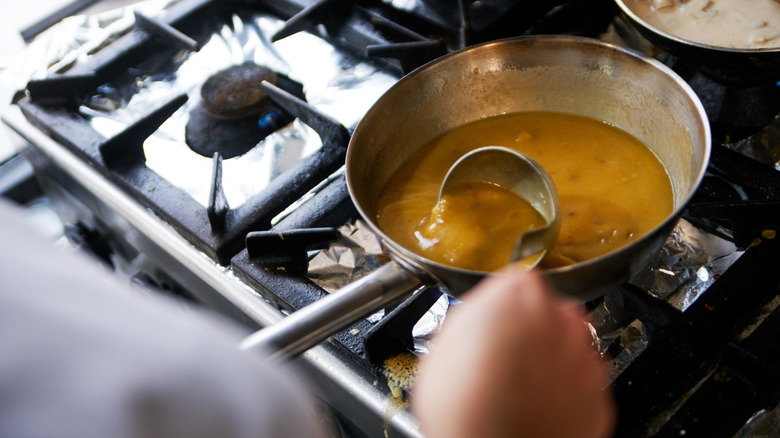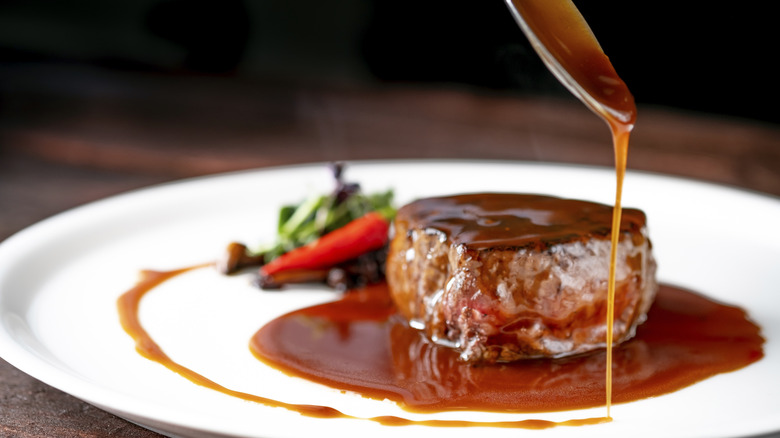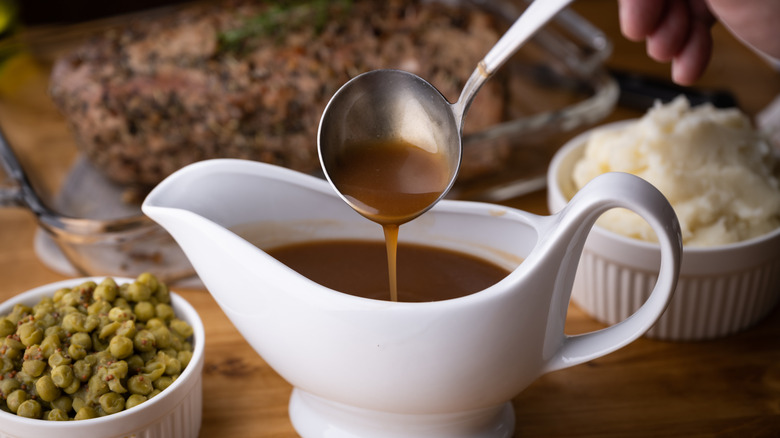What's The Difference Between Gravy And Demi-Glace?
If you're cooking up a meaty meal, from hunky roast beef to pork chops, there's no shortage of sauces you might make to add some moisture and flavor. Two notable sauces in this category are gravy and demi-glace, though if you're just looking at these two sauces, you won't notice any huge difference. They're typically both rich and deep brown in color (white gravies are a notable exception), although if you give them a stir, you may notice some textural differences: Demi-glaces are usually somewhat thick and can be almost syrupy, while gravy tends to be a bit more liquidy. However, their preparations and ingredients are fairly distinct.
Generally speaking, gravy is made with meat juices thickened by a starch such as flour; in practice, it's more of a general category than a specific sauce since gravy can feature all sorts of additions, such as red wine and mushrooms. In contrast, demi-glace has a more precise definition: It's a combination of espagnole sauce and stock. Consequently, you tend to see the same ingredients across many demi-glace recipes.
What to know about demi-glace
As mentioned, demi-glace is a specific sauce. Unlike gravy, which has all sorts of variations, there's a right and wrong way to make demi-glace. You start by making an espagnole sauce: One of the five iconic French "mother sauces" that's often used as a base for other sauces such as chasseur or Madeira. Espagnole sauces start with a mirepoix (chopped onions, carrots, and celery) that's cooked in a good amount of butter before flour is added to make a roux. Then, stock (typically beef or veal) and ingredients such as garlic, peppercorns, bay leaves, and a little tomato puree are added to the roux to turn it into espagnole sauce. This process is pretty similar to gravy, although you don't see ingredients such as tomato in many gravy recipes.
Once you have your espagnole sauce, it's combined with more stock (again, usually beef or veal) and some extra flavorings. This is where demi-glace recipes can vary a bit, with flavoring options including thyme, parsley, peppercorns, and some wine or sherry. It's then reduced significantly; the word "glace" means glaze, so you're almost turning it into a syrup made of super-concentrated stock, which is far thicker than most gravies.
What to know about gravy
The question "what is gravy" is a bit harder to answer than for demi-glace since there's a huge number of gravies with all sorts of bases and flavors. To make things simpler, we'll leave white gravy out of this discussion (it's really more like a béchamel sauce). All of this said, most gravy recipes share some common traits.
A basic gravy starts out with meat drippings (the fat and juices that ooze out as meat cooks). Pretty much any meat can be used. These drippings are then made into a roux with flour before stock (and often wine) are added to turn it into a smooth, thickened sauce — just not nearly as thick as almost-syrupy demi-glace. Of course, vegetarian gravies (and some meat gravies) skip the meat drippings and make the roux with butter, though meat gravy recipes that start this way still add meat stock later. This is just the simplest form of gravy; all manner of herbs, spices, and aromatics can be added. Some common ones are thyme, peppercorns, garlic, and shallots, though other ingredients such as celery, carrot, and mushrooms sometimes appear. Ultimately, this means that most gravies look brown and saucy, but the taste varies immensely. Just try not to make any flour mistakes that cause disappointing gravy.


